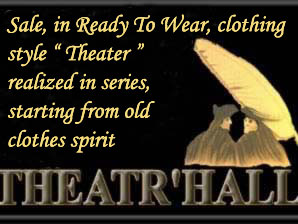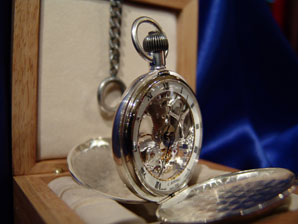 |
 |
||||
 |
|||||
Sales of theatrical clothes and disguises (jabot shirts with or without lace, cape, hats, wigs and Venetian masks, vests and old trousers) for all public, weddings, fancy dress, costumers, and public spectacles.
Also discover on our website all personal achievements, available from stock in our warehouse in Paris.
On our WEB site, you can :
- To buy by correspondence
via this WEB site
and even
CONTACT : THEATRHALL
Phone calls to France: + 33.1.43.26.64.90 (after 15h)
N° VAT Intracomm. - SIRET - APE - RIB - General Conditions of Sale
teatral teatrall teatrale teatrales téâtral
téâtrall téâtrale téâtrales theatrical
théâtrall theatrical theatrical theatrical theatrall theatrical
theatrical theater hall theater all teatrhall teatre hall
Open in 1997, the Museum of the Watch is the fruit of more than 40 years
of research passionate of his/her/its two founders, Gentleman Yves DROZ
and Joseph FLORES.
He/it makes you relive all the history of the watch, since his/her/its
origins, toward 1500, in full rebirth, until our days.
Of the watch to rocket and to foliot, to the electronic watch. Several
thousands of objects retrace these 5 centuries of history, of technique,
of constant evolution, quite the exposition in a perfectly adapted setting.
One forgets the time there while discovering how the men, to be able
to stop it, succeeded in measuring it with more and more precision...
The accessories of indispensable accompaniments to the watch, complete
the exhibition admirably.
The Door-watches - the Keys - the Machines - etc... etc...
The shops of our famous Peasant-watchmakers reconstituted.
All machines for the manufacture of the exhaust to cylinder, so famous
on the tray of the High-Doubs, center world end XIXème.
The unusual research on the exhausts, c.ur of the watch, the one thousand
and one tools of the craftsman watchmaker, one century of watches bracelets,
the watch to a wheel, two copies only known to the world.
We invite you to one virtual visit that, we are convinced some, will
incite you to come to see us...
We wait for you, we will surprise you...!A watch
is a portable clock that carries itself nowadays generally to the wrist,
but the first watches were worn in a pocket of vest, of jacket (or jacket),
or again, attached to the extremity of a short ribbon fixed in top of
the panties or the trousers...
It is necessary to specify an important thing nevertheless: a clock
can only function in only one position. What makes the main characteristic
of the watch on the contrary, it is that she/it walks in all positions.
Of this fact, two technical elements are indispensable to him, whereas
them he/it is not for the clock :
the motor spring, whereas a clock can function with weights whose coming
down manipulates the cog ;
the rooster, who is the point of superior pivotement of the pendulum,
whereas the clock can function with a pendulum.
Summary [to conceal]
1 feature of the different types of watches
1.1 the display
1.2 the mechanism of regulation
1.3 the source of energy
1.4 the fixing to the body
1.5 the qualities
1.6 the supplementary functions
2 the components of a classic watch
3 historic
4 the marks horlogères
5 watches of legend
6 to see also
6.1 article related
6.2 external ties
Feature of the different types of watches [to
modify]
A watch identifies while combining his/her/its features, for example:
analogical display to needle, regulation to quartz, food by battery,
carried to the wrist.
The display [to modify]
Analogical display.Analogical :
the time is indicated by needles
the time is indicated by liquid crystals, under the shape of features
simulating the needles.
Digital display, on the left the hour, on the right the date.Digital
the time is indicated by numbers
mechanical wheels (for example: the days of the month)
the numbers are represented by 7 segments
diode électroluminescente, for which it is necessary to press
a button in order to have the hour because of the strong consumption
of the display
liquid crystals (LCD)
Analogical and digital
for example, of the needles for the hours and the digital displays for
the days of the month.
The mechanism of regulation [to modify]
Photomontage of an analogical display on 10 seconds.Mechanical oscillator
(spring-spiral): in this case, the pendulum, provided with a spring
in the shape of spiral, is animated by a regular oscillating movement.
To adjust the walk of the movement, it is sufficient to act on the spiral:
one increases his/her/its length if the watch advances, because of too
fast oscillations, one decreases it if the watch delays, because of
too slow oscillations. Other means to act on the walk: one modifies
the inertia of the pendulum (for example: radially disposed screws).
Mechanical oscillator to sonic frequency (for example, the tuning fork
of the process Accutron TM, used by the BULOVA mark).
Quartz + electronic circuit
The source of energy [to modify]
A watch can pull its energy from a spring, that is went back up by the
user, went back up by the movements of the body that this one transmits
to a circular masselotte called "rotor (it is then an automatic
rewinding)."
A battery can also provide the energy, but it is necessary then to replace
it by a news when it is exhausted (at the end of a delay of 12 to 30
months in general for the batteries to the oxide of money, of 7 to 10
years po
[Attention ! Le texte à traduire est trop long. La traduction
a été tronquée.]

